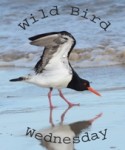This Dicksissel was one of several we saw at Nelson Lake:

I have mentioned before how Mary Lou had scruples about “counting” a bird for her life list until she was satisfied that she had seen most or all of its field marks. (Her refusal to count her first Scarlet Tanager was a case in point.) As to this day’s target bird, Henslow’s Sparrow, we had persued it in several prairie areas, thought we heard it, and caught fleeting glimpses, through thick grass, of a frail looking, big-headed, short tailed and streaky sparrow. In good conscience, and despite the permissive American Birding Association rules of the counting game, neither of us felt comfortable “counting” it, even though we were fairly certain that we had seen one.
Naturally, as soon as we heard that one had been reported at Bill Young/Nelson Lake Marsh Forest Preserve, near our North Aurora, Illinois summer home, we hurried there. As noted in our previous blog, we did get nice views of Grasshopper Sparrows, but chilly winds and the threat of rain made us turn around before we could reach the spot where the Henslow’s Sparrow had been seen.
The next morning (June 4) dawned foggy but mild, so we tried again. The fog lifted, and cloud cover kept us comfortably cool. This time there was no wind to mask the faint trills of the Grasshopper Sparows. We entered the preserve by way of the new north entrance, which has undergone quite a bit of improvement since this map (PDF link below) was published. Now, an asphalt path, flanked by a gravel equestrian trail, loops for almost three miles around the western part of the property. It traverses mostly recovering tall grass prairie, skirting a “prairie pothole” and several other marshy areas.
Mary Lou spotted the first Dicksissel, another species that she had seen previously as a “fly-by” that went uncounted on her life list. This time the views were drop-dead pefect. I had never before seen Dicksissels in such bright plumage.
I learned that Ohio Spiderwort likes damp weather. Many of these subtly beautiful flowers punctuated the prairie landscape:

Walking leisurely and enjoying the wildflowers, we reached the south loop of the trail. Here, the character of the vegetation changed somewhat. It appeared not to have been burnt or mowed as recently as the other fields. Scattered amid the tall grass were scraggled woody shrubs, about 3 or 4 feet high. Henslow’s Sparrows are said to favor a certain stage of prairie succession after fire or disturbance, and our hopes rose.
Sure enough, we soon heard the regular, two-note chirping “ch-lip!” of a Henslow’s. It was quite loud– I expected it to be barely audible– but it was also very difficult to localize. At one point, I thought the bird was in front of me at my feet, and then realized it was behind me! Then we argued about whether it was to our right or to our left. In any event, we failed to catch sight of the bird. It stopped singing, and we continued on until the grassland became more uniform. Rather than completing the loop, we made the wise decision to retrace our steps.
Success:

This time, we heard not one, but two Henslow’s Sparrows singing, and one finally gave us views from about 30 to 40 feet– certainly adequate enough for us to discern its head and face pattern, and its pure white breast with thin brown streaking. The books say its head has a greenish cast, but we wouldn’t call that a field mark. Bill pointed to the sky, the little guy just poured out his heart with song.
Henslow’s Sparrow singing:

We returned home quite satisfied. We both got our life Henslow’s Sparrow, and Mary Lou was now comfortable “counting” her Dicksissel.
I am not yet very familiar with Illinois wildflowers. This showy legume is Wild Blue Indigo (Baptisia australis).
.
Click here for a PDF map of Dick Young/Nelson Lake Marsh Forest Preserve. It does not include the recent trail extensions.
http://www.kaneforest.com/fp/map/DickYoung.pdf













